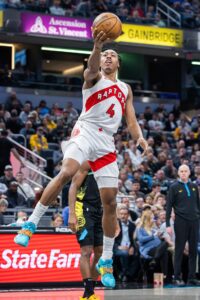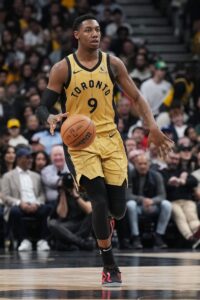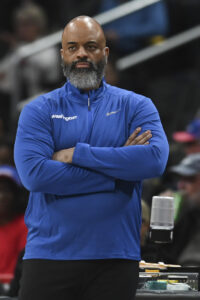The Raptors held their own without Kawhi Leonard following their championship season, winning 53 games in 2019/20 after the star forward departed for Los Angeles. And they remained solidly in the Eastern Conference playoff picture after losing Kyle Lowry two years later to the Heat, winning 48 games in ’21/22.
Eventually though, bleeding talent – including former Coach of the Year Nick Nurse last offseason – caught up with the Raptors, who decided during the 2023/24 season to take a step back by trading away impact forwards Pascal Siakam and OG Anunoby for packages heavy on young talent and future draft picks.
Having moved on from nearly every player who was part of that 2019 championship team (Chris Boucher is still hanging around, for now), the Raptors bottomed out, losing 19 of their final 21 games to close out the 2023/24 season and finishing with a 25-57 record, their worst mark since 2011.
Unfortunately, that wasn’t enough to salvage their 2024 first-round pick, which they traded to San Antonio at the 2023 deadline in a package for Jakob Poeltl. The pick, which was top-six protected, had about a 46% chance to stick with the Raptors, but it ended up slipping to No. 8 on draft lottery day, so it’ll be controlled by the Spurs.
Not having the opportunity to add a potential cornerstone using that lottery pick is discouraging, but president of basketball operations Masai Ujiri has shown in the past that he’s capable of quickly turning around a team’s fortunes, and the Raptors’ roster is hardly devoid of talent. Former Rookie of the Year Scottie Barnes is a future star; Immanuel Quickley looks like the club’s point guard of the future; Canadian forward RJ Barrett played some of the best basketball of his career after coming over in the Anunoby trade; 2023 first-rounder Gradey Dick looked much better in the second half of the season than he did in the first; and the duo of Poeltl and Kelly Olynyk makes for a perfectly serviceable NBA center rotation.
The Raptors’ Offseason Plan
 The good news about the Raptors giving up their 2024 first-round pick is that all of their first-rounders going forward will be unencumbered — if they had kept this year’s pick, they still would’ve owed a lightly protected 2025 first-rounder to the Spurs.
The good news about the Raptors giving up their 2024 first-round pick is that all of their first-rounders going forward will be unencumbered — if they had kept this year’s pick, they still would’ve owed a lightly protected 2025 first-rounder to the Spurs.
That means that if Toronto wants to lean further into its rebuild and aim for a top pick in the 2025 draft, that’s an option. But given the level of veteran talent already on the roster, it may not be the most viable option unless the Raptors follow up their Anunoby and Siakam trades by continuing to sell off vets for long-term assets.
That approach probably doesn’t make sense. Barnes isn’t going anywhere; Quickly and Barrett probably aren’t either. And it’s not as if the Raptors would get a significant haul back if they put solid but unspectacular players like Poeltl, Olynyk, Bruce Brown, and Boucher on the trade block. So it seems safe to assume that Toronto will use its cap room and its draft picks to attempt to move the retooling process incrementally forward, without skipping steps forward or taking another step backward.
That doesn’t mean no veterans will be dealt though. Boucher, who received inconsistent playing time under first-year head coach Darko Rajakovic last season, is an obvious trade candidate entering a contract year. The Raptors should be able to get a second-round pick or two for him if they take back a less favorable expiring deal (perhaps someone like P.J. Tucker). It’s hard to envision them getting a first-round pick back for Boucher even if they’re willing to take on an onerous multiyear contract, but they could potentially land a more productive player in that scenario.
Brown is another trade candidate worth watching. His $23MM team option for 2024/25 is an overpay, so Toronto will have to decide whether or not it makes sense to pick it up at all. Brown is a useful role player who would have significant value if he was earning about half that price, and the Raptors won’t want to lose him for nothing, but they’ll have to scout the market and make sure they extract positive value for him in a trade before they decide to exercise his option.
For what it’s worth, declining the option doesn’t necessarily mean Toronto won’t get anything back for Brown. Non-Bird rights aren’t worth much for a player coming off a minimum or near-minimum salary, but due to his oversized 2023/24 cap hit, Brown’s Non-Bird rights could accommodate a starting salary worth up to $26.4MM. The versatile wing had plenty of suitors in the range of the full mid-level (approximately $12-13MM) last season — it’s possible the Raptors could use their Non-Bird rights to give him a multiyear deal in that neighborhood and sign-and-trade him to an over-the-cap team intent on using its MLE on someone else.
Poeltl is one more trade candidate to keep an eye on, though I suspect he’s more likely to be dealt at the 2025 deadline or the ’25 offseason unless a really favorable offer emerges this summer.
Quickley and Gary Trent Jr. are the Raptors’ two key free agents. Quickley is restricted, which makes his free agency a little more straightforward, but that doesn’t necessarily mean he’ll come at a team-friendly rate. While offer sheets have become increasingly rare, all it takes is one rival suitor to put pressure on Toronto and jack up Quickley’s price.
It’s safe to assume Quickley’s agents will point to deals signed within the past two years by young guards like Tyler Herro (four years, $120MM), Jordan Poole (four years, $123MM), and Devin Vassell (five years, $135MM) as references for Quickley, who finished second in Sixth Man of the Year voting a year ago. The Raptors will argue that Quickley’s résumé isn’t as decorated as that of Herro (2022’s Sixth Man of the Year) or Poole (a key contributor on the Warriors’ 2022 championship team) when they signed their respective extensions, but it’d still be surprising if the young guard gets less than $25MM per year.
Trent is a trickier case. On paper, he looks like an obvious keeper as a 25-year-old who makes three-pointers (38.6% for his career) and has defensive upside. But Trent’s on-court impact has been inconsistent, and depending on his asking price, it’s unclear if it makes sense for the retooling Raptors to invest in him long-term.
As is the case with Brown, Trent is a valuable enough asset that Toronto won’t want to let him go without getting any form of compensation, so perhaps he re-signs with the Raptors at a market-value rate and becomes a potential trade chip sooner rather than later, following in the footsteps of guys like Kyle Kuzma and D’Angelo Russell last year.
While the Raptors don’t control their own lottery pick, they do have a couple selections in the top 31 of this year’s draft, by way of the Pacers (No. 19) and Pistons (No. 31). This year’s draft class may not be elite at the top, but it has solid enough depth, and Toronto will get a couple chances to try to strike gold on a low-cost prospect.
Ujiri and the Raptors often deviate from consensus – most memorably in 2021 by drafting Barnes over Jalen Suggs – so it will be interesting to see how they use those picks. Given how far away they are from contention, they can afford to roll the dice on a younger player rather than going after one who can contribute right away. French forward Tidjane Salaun, Kansas wing Johnny Furphy, Miami swingman Kyshawn George, Pitt guard Carlton Carrington, and G League Ignite forward Tyler Smith are among the players in that range who fit the bill.
Finally, while it may be the most important move the Raptors make this summer, signing Barnes to a rookie scale extension should be fairly straightforward. The step toward stardom that the 22-year-old took in his third season warrants a maximum-salary investment, and no player has ever turned down a max rookie scale extension, so that negotiation shouldn’t be a particularly long one.
Salary Cap Situation
Guaranteed Salary
 RJ Barrett ($25,794,643)
RJ Barrett ($25,794,643)- Jakob Poeltl ($19,500,000)
- Kelly Olynyk ($12,804,878)
- Chris Boucher ($10,810,000)
- Scottie Barnes ($10,130,980)
- Gradey Dick ($4,763,760)
- Jalen McDaniels ($4,741,800)
- Ochai Agbaji ($4,310,280)
- Javon Freeman-Liberty ($100,000)
- Partial guarantee will increase to $150,000 if Freeman-Liberty remains under contract through July 23. Rest of salary noted below.
- Total: $92,856,341
Non-Guaranteed Salary
- Javon Freeman-Liberty ($1,791,857)
- Partial guarantee. Rest of salary noted above.
- D.J. Carton (two-way)
- Mouhamadou Gueye (two-way)
- Total: $1,791,857
Dead/Retained Salary
Player Options
Team Options
Restricted Free Agents
- Immanuel Quickley ($8,486,620 qualifying offer / $12,514,644 cap hold): Bird rights
- Malik Williams ($2,067,722 qualifying offer / $2,067,722 cap hold): Non-Bird rights
- Total (cap holds): $14,582,366
Two-Way Free Agents
Draft Picks
- No. 19 overall pick ($3,475,200 cap hold)
- No. 31 overall pick (no cap hold)
- Total (cap holds): $3,475,200
Extension-Eligible Players
- Scottie Barnes (rookie scale)
- Chris Boucher (veteran)
- Gary Trent Jr. (veteran)
- Extension-eligible until June 30.
Note: Unless otherwise indicated, these players are eligible for extensions beginning in July.
Unrestricted Free Agents
Other Cap Holds
- Will Barton ($2,093,637 cap hold)
- Total (cap holds): $2,093,637
Note: Barton’s cap hold is on the Raptors’ books from a prior season because he hasn’t been renounced. He can’t be used in a sign-and-trade deal.
Cap Exceptions Available
Note: The Raptors project to operate under the cap, though they’ll have the option of remaining over the cap if they retain Brown and Trent. If they were to operate over the cap, they’d lose the room exception and would have access to the mid-level exception ($12,859,000) and three trade exceptions (worth $10,171,292, $1,607,916, and $1,379,527).
- Room exception: $8,006,000
 The good news about the Raptors giving up their 2024 first-round pick is that all of their first-rounders going forward will be unencumbered — if they had kept this year’s pick, they still would’ve owed a lightly protected 2025 first-rounder to the Spurs.
The good news about the Raptors giving up their 2024 first-round pick is that all of their first-rounders going forward will be unencumbered — if they had kept this year’s pick, they still would’ve owed a lightly protected 2025 first-rounder to the Spurs.
 Through the first six games of the Knicks/Pacers series, the home team has dominated. New York has a 3-0 record and a +43 margin at Madison Square Garden, but Indiana has been even better at Gainbridge Fieldhouse, posting a 3-0 record with a +50 margin.
Through the first six games of the Knicks/Pacers series, the home team has dominated. New York has a 3-0 record and a +43 margin at Madison Square Garden, but Indiana has been even better at Gainbridge Fieldhouse, posting a 3-0 record with a +50 margin. Before earning the top spot in Washington, Unseld was a longtime assistant on various NBA coaching staffs. He began his coaching career as an assistant with the Wizards from 2005-11 before joining the Warriors for a season and then being part of the Magic’s staff from 2012-15.
Before earning the top spot in Washington, Unseld was a longtime assistant on various NBA coaching staffs. He began his coaching career as an assistant with the Wizards from 2005-11 before joining the Warriors for a season and then being part of the Magic’s staff from 2012-15.